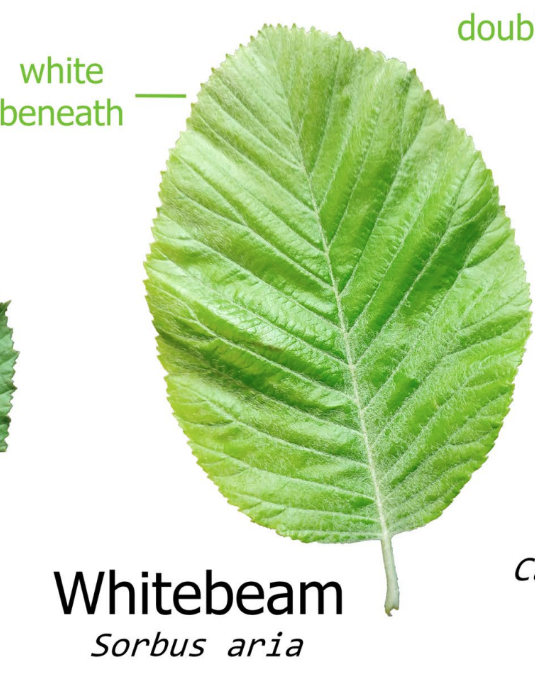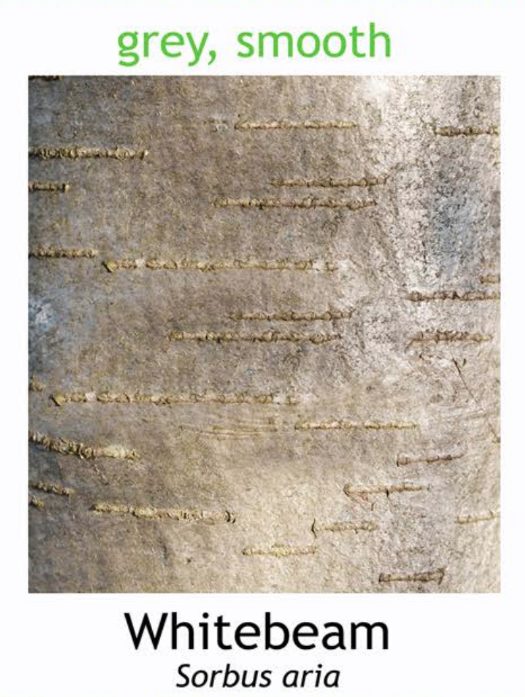Recognising the Whitebeam Tree:
-
Leaves: The leaves of the Whitebeam tree are oval to elliptical in shape, with serrated margins. They are dark green in color on the upper surface and have a white or silvery underside, which gives the tree its name.
-
Bark: The bark of the Whitebeam tree is smooth and greyish-brown when young, becoming rougher and more fissured with age. It has a distinctive mottled appearance and is often covered in lichens and mosses.
-
Flowers: Whitebeam trees produce clusters of small, creamy-white flowers in late spring to early summer. The flowers have five petals and are arranged in large, flat-topped clusters known as corymbs.
-
Fruits: After flowering, Whitebeam trees produce small, round fruits known as pomes. The fruits ripen from green to yellow or orange in autumn and may persist on the tree into winter.
-
Shape: Whitebeam trees have a rounded to spreading canopy with sturdy branches and a straight, tall trunk. They can grow to significant heights, with some specimens reaching over 20 meters tall.



5 Interesting Facts about the Whitebeam Tree:
-
Endemic Species: The Whitebeam tree is considered a "Celtic relic," meaning it is a remnant of ancient woodland that survived the last Ice Age in isolated pockets in Ireland, Britain, and western Europe. It is endemic to these regions and is found nowhere else in the world.
-
Biodiversity Hotspot: Whitebeam trees support a wide range of wildlife species, including birds, mammals, insects, and fungi. Their foliage provides food and shelter for caterpillars, which in turn are prey for birds such as tits, warblers, and finches. The fruits are also eaten by birds and small mammals, contributing to overall ecosystem biodiversity.
-
Cultural Significance: Whitebeam trees have cultural and symbolic significance in Celtic and other European traditions. They have been associated with protection, wisdom, and spirituality and have been planted near homes, churches, and sacred sites for their perceived magical properties.
-
Habitat Diversity: Whitebeam trees are adaptable and can grow in a variety of habitats, including woodlands, hedgerows, limestone cliffs, and rocky outcrops. They are often found in association with other broadleaf tree species and contribute to habitat diversity and complexity in natural ecosystems.
-
Conservation Status: Some species of Whitebeam trees are listed as priority species for conservation in Ireland and Britain due to their limited distribution and vulnerability to habitat loss, climate change, and other threats. Conservation efforts are underway to protect and restore populations of these rare and endangered trees.
Uses of the Whitebeam Tree:
-
Ornamental Planting: Whitebeam trees are valued in landscaping for their attractive foliage, flowers, and fruits. They are often planted in parks, gardens, and landscapes as specimen trees, shade trees, and ornamental accents.
-
Wildlife Habitat: Whitebeam trees provide valuable habitat and food for a variety of wildlife species. Their foliage provides shelter and nesting sites for birds and small mammals, while their fruits are eaten by birds and mammals, contributing to overall ecosystem biodiversity.
-
Historical Uses: Various parts of the Whitebeam tree have been used historically for medicinal, culinary, and practical purposes. The fruits were traditionally used to make jams, jellies, and alcoholic beverages, while the wood was used for carving, turning, and fuelwood.
Contribution to Biodiversity:
-
Wildlife Food Source: Whitebeam trees contribute to biodiversity by providing habitat and food for a wide range of wildlife species. Their foliage, flowers, and fruits are important sources of food for birds, mammals, insects, and other organisms, supporting diverse populations in woodland, hedgerow, and limestone habitats.
-
Habitat Provider: Whitebeam trees provide valuable habitat and shelter for wildlife species, particularly in fragmented or degraded landscapes. Their presence enhances habitat complexity and supports populations of birds, mammals, insects, and fungi, contributing to overall ecosystem health and resilience.
-
Genetic Diversity: Whitebeam trees are important for maintaining genetic diversity within their populations and ecosystems. They have adapted to a range of environmental conditions and provide valuable genetic resources for breeding programs and conservation efforts aimed at preserving rare and endangered tree species.
In summary, the Whitebeam tree is recognisable by its dark green leaves with white or silvery undersides, creamy-white flowers, and small round fruits. It holds cultural significance, provides valuable resources for wildlife, and contributes to biodiversity and ecosystem health in Ireland's woodlands, hedgerows, and limestone habitats. Additionally, it serves as an ornamental tree, supports wildlife populations, and enhances habitat diversity in natural ecosystems.
Images taken from the beautiful posters created by Phil Barnett and you can download these and/or purchase other great designs from his online shop.
